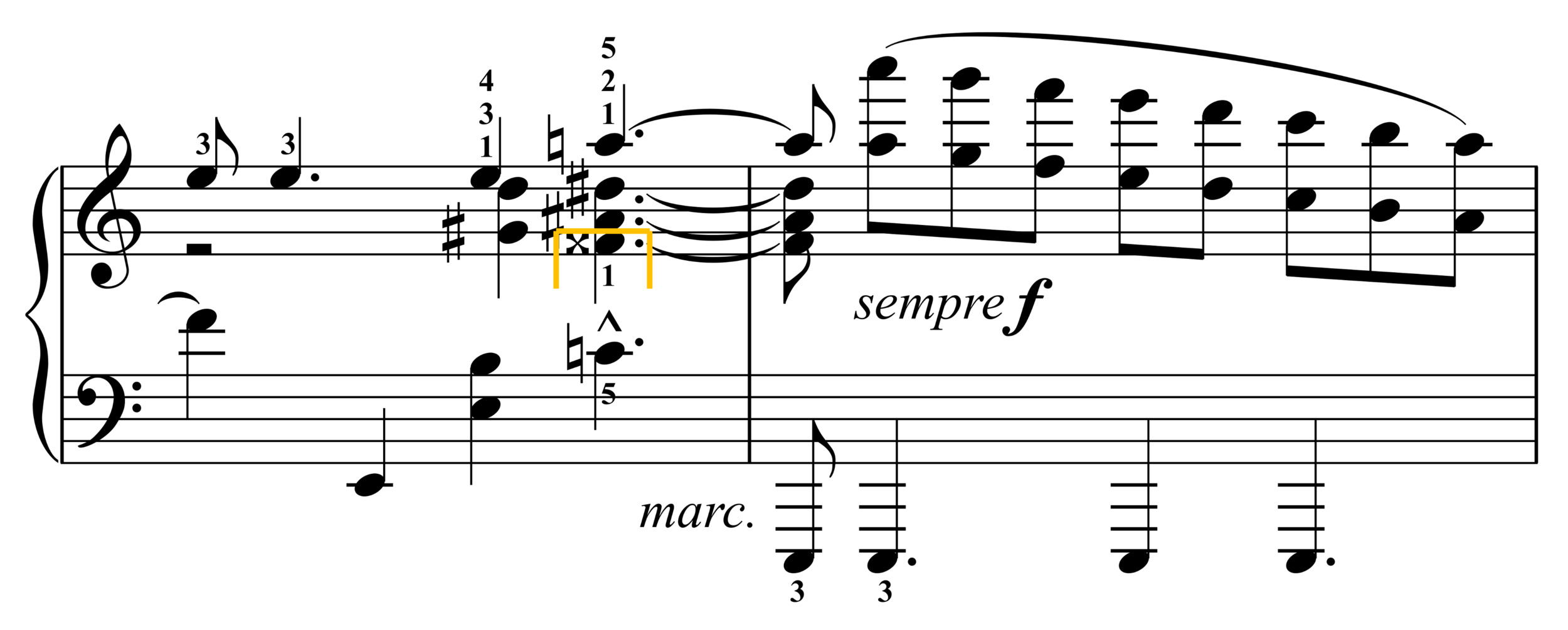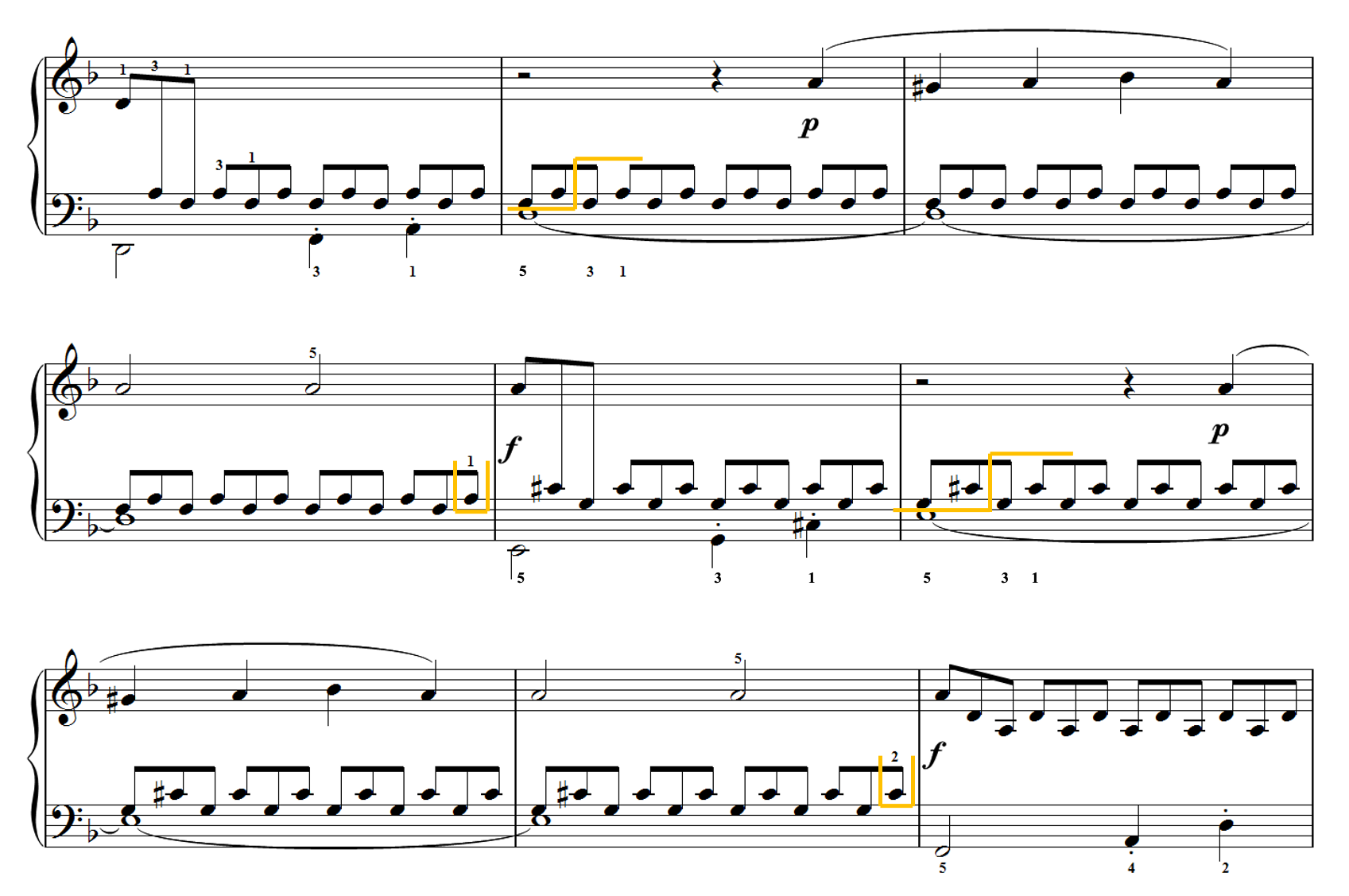Original:
Suggested performance:
“This redistribution keeps the thumbs on the same notes in mm. 217–19.”
Submitted by Michael Clark
Published on 1/1/2020
Original:

Suggested performance:

“This redistribution keeps the thumbs on the same notes in mm. 217–19.”
Submitted by Michael Clark
Published on 1/1/2020

“Taking the B in the right hand allows the bass note to be sustained slightly longer.”
Submitted by Michael Clark
Published on 1/9/2022

“Taking the E in the left hand allows a legato connection into the C in the top line.”
Submitted by Michael Clark
Published on 1/1/2020

“Taking the F-double-sharp in the left hand allows the right hand to maintain a more compact hand shape and thus provides a more powerful delivery.”
Submitted by Michael Clark
Published on 1/1/2020

Submitted by Michael Lenahan
Published on 1/21/2022

“This unorthodox fingering is no more difficult to master than more traditional fingerings, but it also has the advantage of making Beethoven's original articulations come out clearly and effortlessly.”
Submitted by Noah Sonderling with thanks to Elisabeth Wright
Published on 10/4/2020

“These redistributions allow for maximum legato connections in as many parts as possible.”
Submitted by Michael Clark
Published on 1/1/2020

“Taking the first notes of each group with the left hand limits the right-hand figure to only two positions.”
Submitted by Michael Clark with thanks to Nancy Weems
Published on 1/1/2020

“I find taking the C in the right hand makes it easier to get my left-hand thumb on G in beat 3.”
Submitted by Michael Clark
Published on 1/1/2020

“Taking the bottom octave in the left hand makes it possible to trill with stronger fingers.”
Submitted by Michael Clark
Published on 1/1/2020

“Changing the pedal with the melodic line allows the left hand to sneak up to take the E-flat from the alto line, freeing the right hand for a more relaxed trill.”
Submitted by Michael Clark
Published on 1/1/2020

“Taking the bottom octave in the left hand makes it possible to trill with stronger fingers.”
Submitted by Michael Clark
Published on 1/1/2020

“The left hand is positioned above the right in mm. 50–51. Taking the G in the right hand in m. 52 eliminates an awkward jump in the left hand and allows the left hand the opportunity to get below the right hand for the rest of the passage.”
Submitted by Michael Clark
Published on 1/1/2020

“The B-flat eighth note evenly divides the left-hand leap, and I find it easier to play it between the E-flat octaves in the left hand than with the right hand.”
Submitted by Michael Clark
Published on 1/1/2020

“The left hand is positioned above the right in the beginning of m. 218. Taking the B-natural in the right hand eliminates an awkward jump in the left hand and allows the left hand the opportunity to get below the right hand for the rest of the passage.”
Submitted by Michael Clark
Published on 1/1/2020

Submitted by Bang Hean Loo
Published on 5/22/2025
“This arrangement enables the thirds to sound much smoother.”

“Taking the final triplet before the leap in the right hand makes the leap more secure.”
Submitted by Michael Clark
Published on 4/18/2020
RH in red, LH in blue

“When the bass is a whole note, hold the pedal for four beats so the bass sustains while the left hand crosses over the right. This redistribution feels more secure to me than the awkward leap involved in trading the triplets between the hands.”
Submitted by Michael Clark with thanks to Robert Roux
Published on 4/18/2020